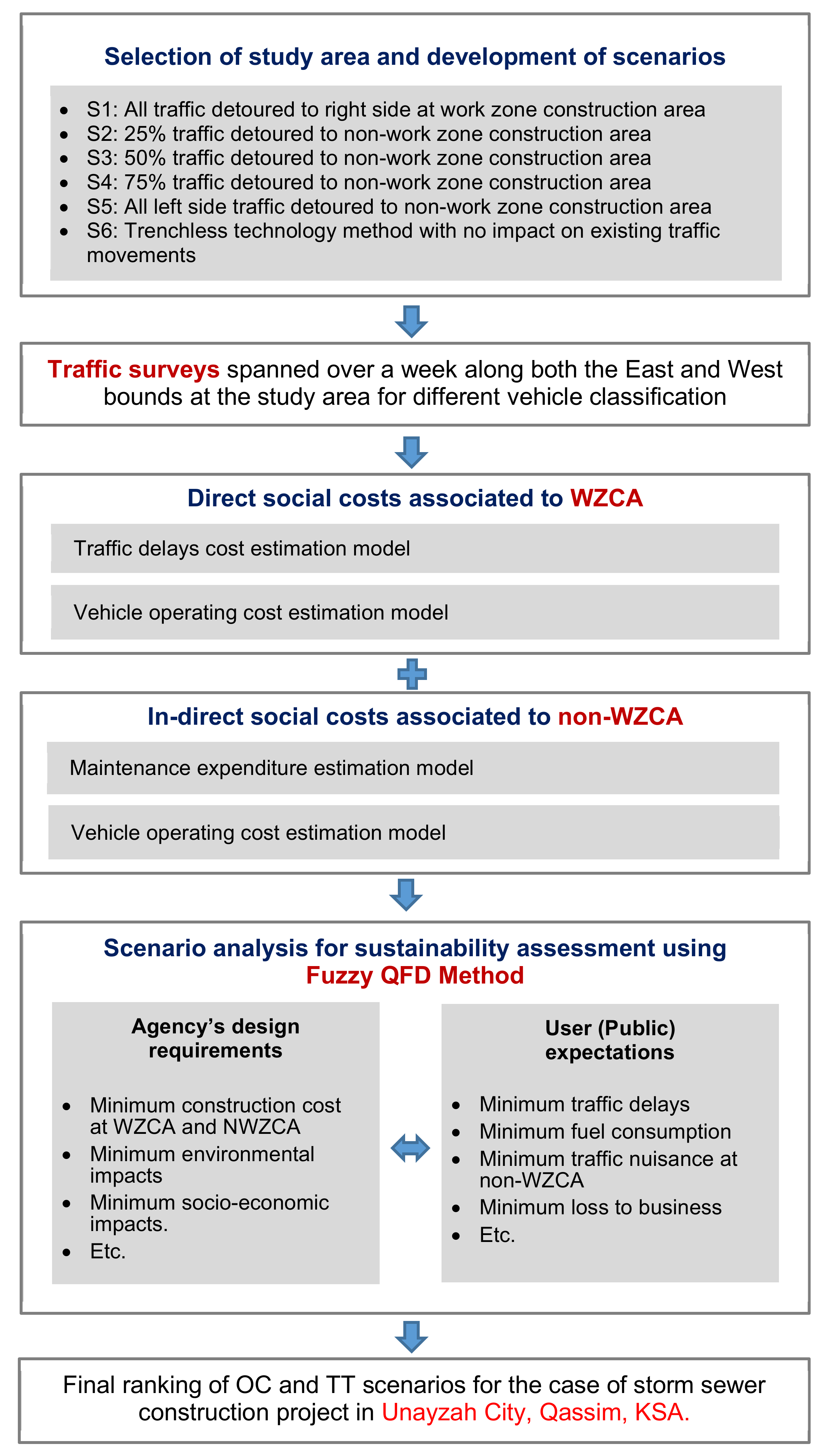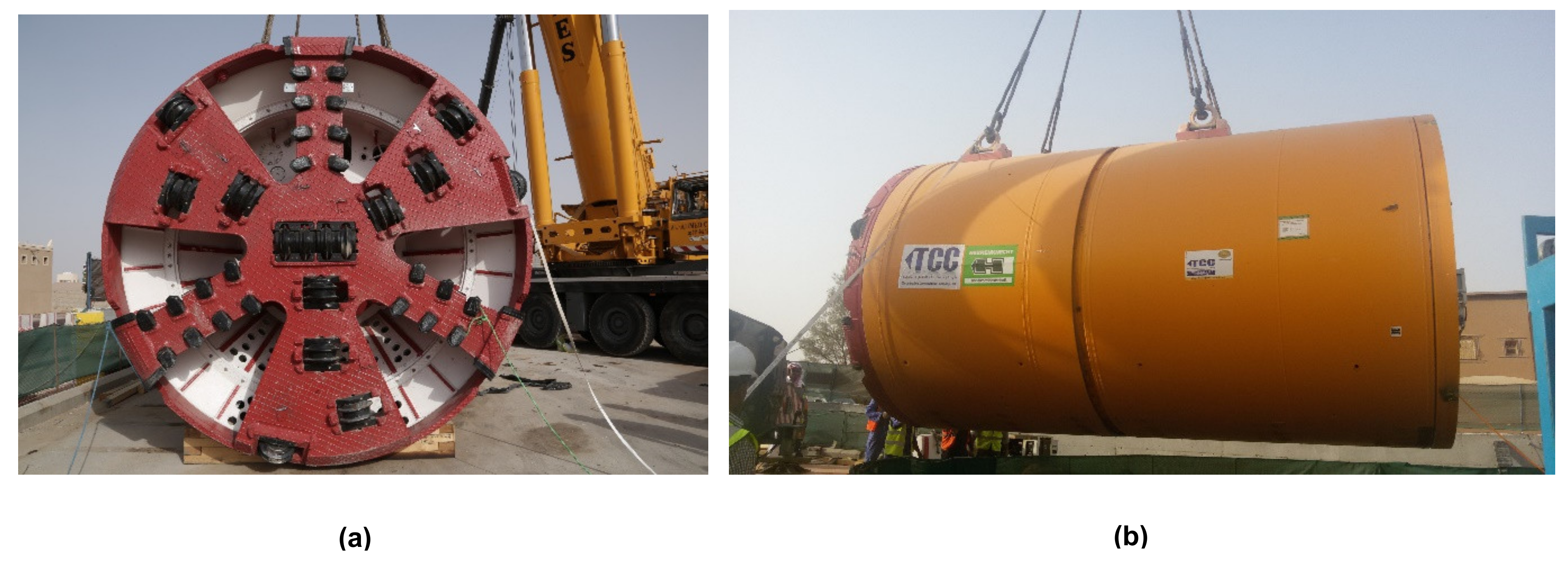2.2. Social Costs at Work Zone Construction Area
Performing a utility cut requires the establishment of work zones, which are known to influence traffic mobility. In most cases, work zones delay traffic due to lane closures or block access to certain locations, forcing traffic to reroute and travel longer distances. These impacts often result in costs to the traffic users. Such costs depend mainly on the characteristics of the established work zone, for example, the lane closures and speed limits necessitated by the work zone. Existing models can be used to estimate the travel delay costs and vehicle operating costs, such as the model for travel delay costs in Equation (1) [
14,
15,
16].
where
is work zone travel delay cost,
is work zone duration in days,
is the number of vehicles delayed by the speed change for vehicle class
,
is the travel time difference resulting from the speed changes due to the work zone for vehicle class
in hours,
is the delay cost rate for vehicle class
in dollars/mile, and
is vehicle class (truck or auto).
The work zone vehicle operating costs incurred due to increased fuel consumption can be estimated using AASHTO methodology, as shown in Equation (2) [
14].
where
is work zone vehicle operating cost,
is the amount of fuel consumed due to delay in gallons/hour for vehicle class
, and
is the average fuel price in dollars/gallon consumed by vehicle class
.
2.3. Social Costs at Non Work Zone Construction Area
Pavement performance models are statistical models developed to represents the deterioration mechanism of pavements under different factors. These performance models are functions of the significant factors that are believed to have an influence on pavement condition. One of these factors that is proven to have an impact on pavement condition is the cumulative traffic loading. The amount of cumulative traffic loading, correlates positively with the accelerated pavement deterioration rates. Accordingly, unexpected high traffic volume on alternate routes can potentially cause these roads to have a higher deterioration rate. Therefore, to assess this reduction in pavement condition caused by increasing traffic volume, a pavement performance model needs to be developed. The general form of the performance model is termed in Equation (3).
where
is the response variable of the performance model that represent the level of pavement condition and likely denoted in term of performance indices,
is a vector of predictor variables (such as material type, accumulated traffic loading, weather severity),
is a set of parameters to be estimated and
is a mathematical form used to describe the variation of the response as function of the predictor variables.
The cost of maintaining pavements relies significantly on its condition or state. The worse the pavement conditions get, the more likely agencies are to spend money on maintaining it [
17]. Therefore, in order to estimate maintenance expenditures, the conditions of the pavement need to be assessed using Equation (3). Then, associated maintenance expenditures corresponding to those pavement conditions are estimated. The general form of the maintenance expenditures model is termed in Equation (4).
where
is the maintenance expenditures for pavement section (i);
is a vector of predictor variables (such as traffic level and weather severity);
is pavement performance level at treatment application time;
is a set of parameters to be estimated and
is a mathematical form used to describe the variation of the response as a function of the predictor variables.
User costs, typically, are those incurred by users due to their normal use of the asset over its service life. An example of these user costs is vehicle operating costs (VOC). VOC is typically represented by the amount of money (typically is expressed in cents) spent for each mile traveled by each vehicle. These costs consist of fuel, tires, repairs and, car depreciation cost due to high mileages. One of the significant factors that increases these costs is the pavement roughness level [
18]. An example of the effect of poor pavement condition (very rough pavement) on VOC is that road users might drive slowly which possibly results in high fuel consumption [
19]. Typically, pavement roughness is measured in term of Present Serviceability Rating (PSR) and International Roughness Index (IRI), which are typically modeled as the response (dependent) variable of a pavement performance model using Equation (3). Having pavement roughness determined, the corresponding VOC can be then estimated using the VOC model presented in Equation (5).
where
is vehicle operating cost estimated for vehicle (i);
is a vector of predictor variables (such as vehicle type and age);
is pavement performance level;
is a set of parameters to be estimated and
is a mathematical form used to describe the variation of the response as a function of the predictor variables.
2.4. Social Cost Savings with Trenchless Technology
The reduction in maintenance expenditures could cause significant agency cost savings. An example of these can be the possible reduction in maintenance expenditures that result from employing TT methods. Adopting TT, which requires no or minimal work zone areas, results in almost no traffic increase on adjacent local streets. Conversely, open cut methods typically require large work zone areas which often cause/force traffic to detour to adjacent roads resulting in unexpected traffic volume on those roads. Since the pavement deterioration rate is impacted significantly by the amount of traffic volume, the needs for maintenance and rehabilitation activities on those adjacent roads might increase. Therefore, by adopting TT, transportation agencies might minimize their maintenance expenditures on these adjacent roads.
To estimate reduction/savings in an agency’s maintenance expenditures on alternative roads, the comparison of alternative construction techniques (i.e., TT vs. open cut methods) needs to be conducted. In the case of employing TT, traffic volume on alternative roads are expected to remain unchanged. On the other hand, open cut method is expected to increase traffic volume on adjacent roads. Therefore, the extra maintenance expenditures incurred due to unexpected high traffic volume are quantified by taking the difference between the estimated maintenance expenditures on alternative roads for the open cut and TT scenarios. This difference in maintenance expenditures represents agency cost savings and can be calculated using Equation (6).
where
is agency cost savings;
is maintenance expenditures under normal operating condition corresponding to route i;
is maintenance expenditures under high traffic volume corresponding to route i;
represents number of adjacent routes.
Savings in VOC can be seen as a type of user cost savings. User cost savings can be estimated as the reduction in VOC when TT is implemented compared to the case where open cut method is considered. The general form of estimating user cost savings is presented in the following equation:
where
is user cost savings;
is vehicle operating cost under normal operating condition corresponding to vehicle i;
is vehicle operating cost under high traffic volume corresponding to vehicle i;
represents number of vehicles impacted by pavement condition.
2.5. Fuzzy Quality Function Deployment Method
During the recent past, QFD has been widely recognized as a decision-making tool for site selection process [
20]. According to the fundamental idea of QFD, consumer needs are translated into technical requirements of the product by developing a House of Quality (HoQ) (see
Figure 2). The HoQ is essentially a combinations of various matrices that translate the data or information obtained by the experts on: (i) What should be done related to the customer requirements?, (ii) How to relate customer requirements with the product requirements?, and (iii) What is the relationship between product requirements and the desired benchmarks? [
21].
In present research, the agency’s objectives are essentially the design requirements (DR) while the customer requirements (CR) are the expectations of public (e.g., road users, visitors of the commercial area, and residents of both the WZCA and non-WZCA) during the period of construction. Subjective assessment of some of the agency requirements and public expectations introduce uncertainty in the decision-making process due to vagueness in expert judgment. In present research, this limitation has been addressed by integrating the fuzzy set theory with conventional QFD.
Following is the step-by-step procedure of Fuzzy-QFD for analyzing different scenarios for traffic movements due to open cut and trenchless technologies [
20]:
Step 1: The customer requirements (CR) or the public expectations (PE) are defined as: (i) minimum travel time, (ii) minimum fuel consumption, (iii) minimum air and noise pollution, (iv) minimum traffic nuisance at NWZCA (e.g., increase risk of accidents and stress level in residents of a calm neighbourhood), and v) minimum loss in business. This step correspond to the component “A” of HoQ shown in
Figure 2.
Step 2: The design requirements (DR), i.e., the component “C” of HoQ shown in
Figure 2, are defined below as the following sustainability objectives (SO) which the agency or the private contractor require to obtain:
Low Agency Cost—this includes total cost of material, labour, and other miscellaneous costs. This also includes the pavement restoration cost in case of open cut construction along with the pavement maintenance cost at NWZCA.
Low User Cost at WZCA—This includes travel delay and vehicle operating costs at the work zone construction area.
Low User Cost at non-WZCA—It includes vehicle operating cost at NWZCA.
Low Environmental Impacts—This includes the possible increase in impacts of air and noise pollution at both the work zone and non-work zone during the construction period.
Low Socio-economic Impacts—This includes the impacts on socio-economics setting of the area, such as loss of business and increase in traffic congestion during the construction period.
Step 3: Determine the priorities of public expectations (PE) by using Triangular Fuzzy Numbers (TFNs) for defining the priority of each requirement.
Step 4: Determine the weight of each decision-maker. As all the decision-makers in present research were highly qualified and experienced with ample indigenous know-how of the study area, equal weights were allocated to all of the four decision-makers.
Step 5: Estimate the aggregated weights
) assigned by the decision-makers for PE using the following Equation (8):
where p is the number of CR (p = 1, 2,..., P).
Step 6: Ascertain the relationships among the PE and SO using linguistic scales for the TFNs illustrated in
Figure 3. This step completes the component “D” of HoQ in
Figure 2.
Step 7: Estimate the aggregated weights (
apm) between PE and SO with the help of Equation (9).
where
N denotes the number of decision makers
(n = 1, 2,…, N) and
M is the number of
DR (m = 1, 2,..., M). This Equation (9) fills component (B) of
Figure 3.
Step 8: Determine the prioritized technical descriptors to complete the matrix. Equation (10) estimates the weights of the SO
(fm) from the aggregated weight for PE
(wp) and aggregated weights between the SO and PE (
apm).
Step 9: Evaluate each scenario (refer to
Figure 1) against all the SO and the combine the results with the weight of each SO for final ranking of the scenarios. Subsequently, calculate the rating of each scenario (SR) using Equation (11).
where
K presents the number of scenarios
(k = 1, 2, …, K).
Step 10: Calculate the fuzzy index (
FI) using Equation (12) for expressing the degree to which a scenario complies with the desired SO.
Step 11: Finally, use Equation (13) to de-fuzzify the TFNs obtained from Step 10 to rank all the pipeline construction scenarios.
where
Rk is the priority rank of each SHP site and
a,b,&c are the upper, middle, and lower bounds of the aggregated TFN.















